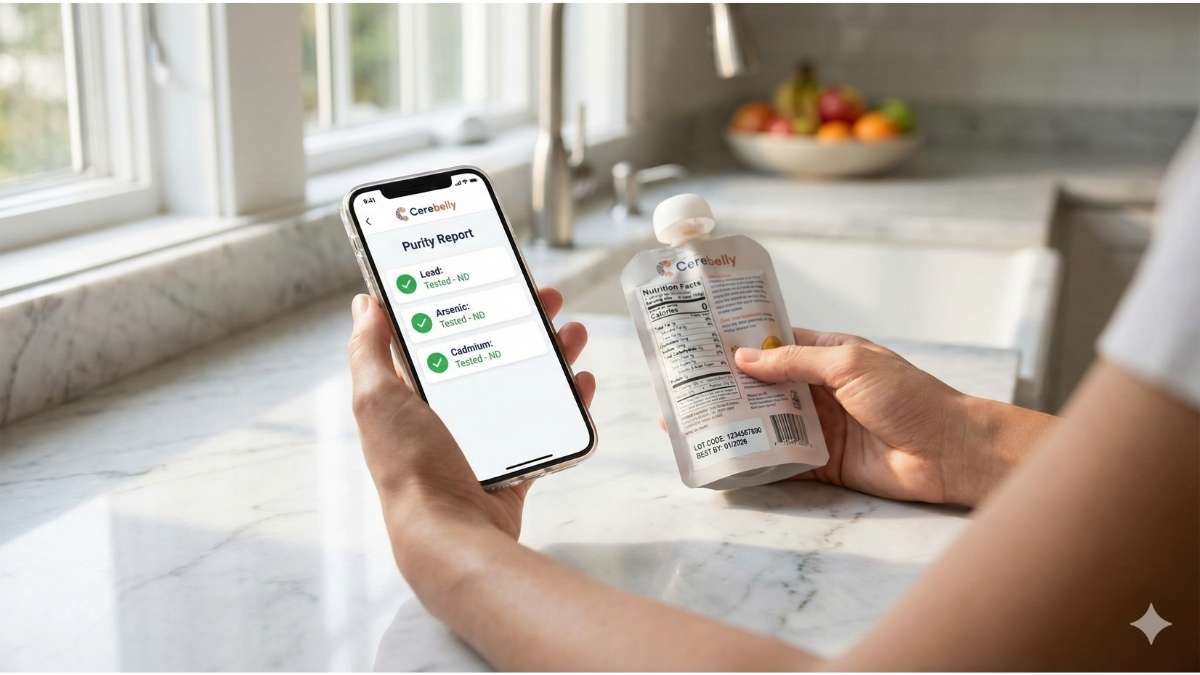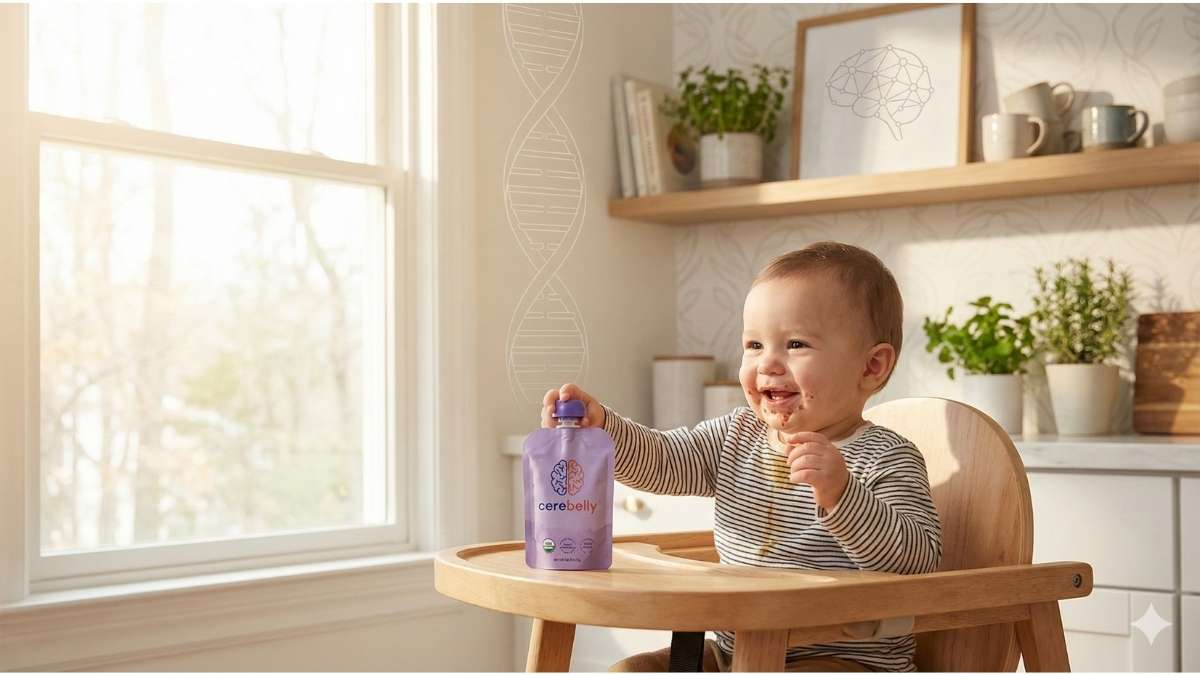Cerebelly Baby Food Heavy Metals: The Scientific Path to
Verifiable Purity
You did everything right. You became the Proactive Protector, choosing organic food because you wanted the purest, safest start for your baby, free from pesticides. That fierce, protective kind of love is the best there is.
But then, that gut-punch feeling when you read the headlines. Toxic heavy metals—arsenic, lead, and cadmium—are hiding even in foods with the organic seal. It feels like a betrayal. You are left anxious, searching for real answers and solid proof.
You need to know: Is the food you lovingly choose actually safe?
Specifically, when you search for Cerebelly baby food heavy metals, you’re looking for accountability, not just marketing claims. As a PhD scholar who also grew up farming, I know the difference between trusting a process and verifying a product. The USDA Organic Seal is necessary, but it is no longer the final word on purity. We need verifiable data. This deep dive will deliver the scientific certainty and verifiable purity you need to get your confidence back and feel genuine relief.
Neuro-Purity & Safety Takeaways
- 🧠 Designed for Brain Development: Unlike standard baby brands, Cerebelly was founded by a practicing neurosurgeon. Every pouch is formulated to deliver specific nutrients during your baby's "Critical Brain Windows," ensuring food fuels cognitive growth rather than just filling a tummy.
- 🔍 The Transparency "Gold Standard": Cerebelly offers radical accountability through its Lot Code Transparency Protocol. You can enter the unique code from your specific pouch online to view precise test results for heavy metals like lead and arsenic, rather than relying on industry averages.
- 🛡️ Third-Party Validated Purity: Addressing the "Organic Paradox" where soil contaminants persist, Cerebelly consistently earns the Clean Label Project Purity Award. This certification verifies that their supply chain effectively filters out over 400 contaminants before ingredients ever reach production.
- ✅ Proactive Risk Elimination: While competitors may face litigation over hidden data, Cerebelly tests every single batch. This ensures that any product with elevated levels is stopped at the facility, providing you with verifiable scientific proof of safety in hand.
The Neurosurgeon's Mandate—Purity as the Foundation of
Brain Health
Let's start with what truly sets this brand apart: its commitment to neuroscience. Dr. Theresa Purzner, a practicing neurosurgeon, founded Cerebelly. This isn't a marketing claim; it's their mission statement.
Cerebelly's products are designed around the concept of "Critical Brain Windows." These are specific, timed periods when your baby's brain requires certain nutrients—like Choline, Iron, or DHA—to build key structures and connections.
This focus on maximizing neurodevelopment immediately establishes a non-negotiable safety requirement: You cannot maximize neurobenefits with neurotoxins.
If a food contains neurotoxins—metals like lead or arsenic—the potential neuro-benefit derived from the targeted nutrients is effectively compromised. Purity is not a side feature; it is the absolute foundation required to deliver on the promise of optimized brain health. This commitment to scientific authority compels the brand to adopt standards that go far beyond regulatory requirements.
The Organic Paradox and The Vicious Heavy Metal Cycle
As a PhD Student in agriculture, I know the anxiety you feel when you hear about contaminants in organic food. It comes down to one core truth: organic farming, while essential, cannot fully undo the past.
The Farmer’s Insight: Cleaning the Sponge
On the farm, we talk about soil health. Think of the earth as a massive sponge that has absorbed contaminants for generations—from industrial runoff, leaded gasoline, and historical use of arsenic-based pesticides. Even with the cleanest organic practices today, those metals remain in the soil. When plants draw up water, they absorb these trace contaminants, too.
This is the Purity Paradox: you successfully eliminated synthetic pesticides (the Proactive Protection), but you now face naturally occurring heavy metals.
This is why we need third-party validation that confirms the final product is clean. The Clean Label Project (CLP) Purity Award serves as this critical assurance. It proves that Cerebelly's supply chain—their sourcing of ingredients from specific, cleaner regions—is effective. The CLP Award is the necessary Accountability baseline that verifies the company is doing the hard work of sourcing superior ingredients.
Ultimate Accountability—The Lot Code Transparency
Protocol
While the CLP Award confirms Cerebelly starts with cleaner ingredients, the Lot Code Transparency Protocol is the definitive, gold-standard proof that offers maximum relief. This is where Cerebelly distinguishes itself entirely.
It's one thing for a brand to say, "We tested our products generally." It's another thing entirely to let you verify the specific results for the pouch in your hand.
 Verify your pouch now. Enter the code on the back to see the exact purity data for your specific batch.
Verify your pouch now. Enter the code on the back to see the exact purity data for your specific batch.The Lot Code Difference
Every single Cerebelly product carries a “lot code”. This code represents a specific, tested batch. You can enter that code online and retrieve the actual testing certificate—including parts per billion (ppb) measurements for Lead, Arsenic, Cadmium, and Mercury—for that exact batch of product.
This level of accountability is radical because it overcomes the critical flaw in aggregated industry data. Most brands, if they test at all, only share averaged, general results that can mask contamination spikes or inconsistencies between batches.
The Lot Code system ensures:
1. Batch-Specific Confidence: You receive real-time, specific data, converting general trustworthiness into verifiable scientific proof.
2. Proactive Risk Management: By testing every batch, Cerebelly ensures that products with elevated levels are withheld before they ever reach the store shelf.
This is why, when you wonder if Cerebelly baby food is safe? The answer is backed by a proprietary data system designed for your self-verification.
Competitive Scrutiny—Accountability vs. Litigation
The necessity of Cerebelly’s radical transparency is underscored by the current climate of litigation over heavy metals in baby food. You, the Proactive Protector, have every reason to be skeptical of established brands.
Many major, high-volume competitors—are currently defending mass torts and class-action lawsuits. The foundation of these lawsuits is damning government reports showing that these companies used internal standards that permitted contamination levels far above what the FDA deems safe for other products.
- The Problem of Secrecy: When companies fail to show internal testing data or refuse to cooperate with congressional investigations, they create a massive Trustworthiness deficit. They wait for a crisis to occur.
- The Cerebelly Defense: Cerebelly’s lot code system functions as a robust internal defense, designed to prevent issues that might lead to an anxious search for a Cerebelly baby food recall. By proactively sharing the data for every single production batch, they maintain their Confidence and demonstrate that their quality control is not a compliance issue, but a moral commitment.
The choice is stark: between brands that hide behind legal processes and one brand that provides the data on demand.
Investing in Verifiable Peace of Mind
The comprehensive analysis confirms that Cerebelly Organic Baby Food has invested significantly in safety measures that justify its premium position.
You are investing in a product where the cost reflects:
- Neuro-Scientific Design: Ensuring every nutrient is precisely balanced for brain development.
- CLP Verification: Confirming superior, third-party-vetted sourcing.
- Lot Code Transparency: Providing the highest possible level of Accountability and Verifiable Purity.
For the Proactive Protector who demands both scientific rigor and data, Cerebelly’s system delivers quantifiable Peace of Mind. You can finally stop worrying about every ingredient label and feel assured that data, not just marketing, backs your choice.
For Further Reading:
The core of the Cerebelly organic baby food review is heavy metals, transparency, and neuro-nutrition, the following links will reinforce these specific themes.
Here are three reliable sources:
1. Read more on the importance of third-party verification and purity standards
2. Review the official report that exposed heavy metals in the baby food industry
3. Learn how to check your specific product batch for heavy metal testing results


